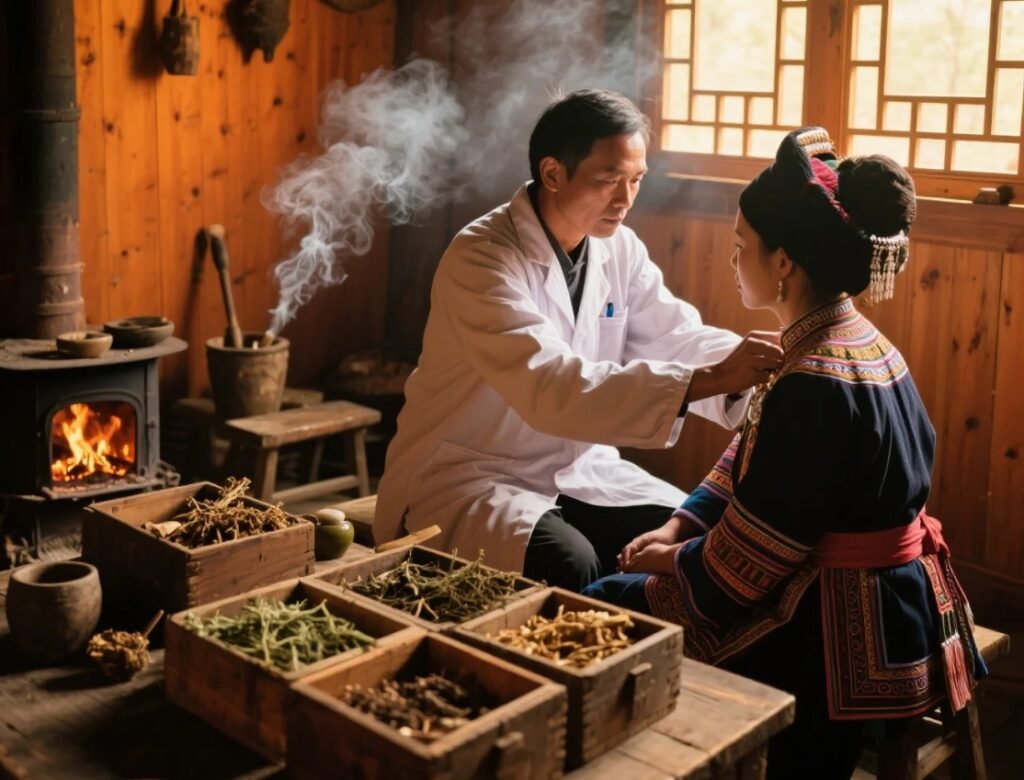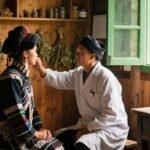Mongb gangb ghab jud ghad (Hemorrhoids) in Miao Medicine
Overview
The term “hemorrhoids” was introduced into Miao regions in modern times. In Miao- medicine, hemorrhoids are referred to as Mongb gangb ghab jud ghad, also known as ganggan jiangdian or ganggan mong. This condition results from individual constitution and postural changes affecting blood flow, which leads to qi stagnation and blood stasis. Aging, chronic illness, pregnancy, prolonged sitting, and other factors can contribute to the development of hemorrhoids.
In Traditional Chinese Medicine (TCM), hemorrhoids are considered vascular swellings formed by dilation and tortuosity of the rectal venous plexus beneath the rectal mucosa or anal skin. They can affect people of all ages and genders, with young and middle-aged adults being the most affected—hence the saying “nine out of ten people have hemorrhoids.” Hemorrhoids are classified as internal, external, or mixed based on their location.
In Western medicine, this condition also corresponds to hemorrhoids and can be diagnosed and treated with reference to this description.
Classification in Miao -Medicine
Miao- medicine divides hemorrhoids into two types:
Internal hemorrhoids, described as “rats stealing feces”
External hemorrhoids, referred to as “rats digging holes”
Causes
Miao -medicine holds that “a hundred bodies produce a hundred diseases”—each person’s constitution is different. Elderly individuals, pregnant women, and those with chronic conditions are more susceptible. Miao philosophy emphasizes the harmony between humans and nature. According to this view, human health is deeply affected by natural forces. Therefore, living in accordance with natural principles—such as moderate labor and balanced rest—is essential. Prolonged sitting is considered a major lifestyle misalignment that increases the risk of hemorrhoids.
Pathogenesis
Poor constitution and unhealthy habits lead to disrupted blood flow in the anorectal area. This causes qi stagnation, blood stasis, and internal accumulation of toxins, which over time results in the formation of hemorrhoids.
Diagnostic Essentials
Diagnosis Criteria:
Internal hemorrhoids: Usually occur in adults. Early signs include painless rectal bleeding during defecation, typically in the form of drops or spurts. Bleeding is intermittent and may be triggered by alcohol consumption, overexertion, constipation, or diarrhea. Severe bleeding may lead to anemia. On physical exam, soft hemispherical masses are seen above the dentate line, in shades of red, dark red, or grayish white. As hemorrhoids enlarge, they may prolapse during defecation or coughing. If not manually reduced, they may become incarcerated, accompanied by discharge and anal heaviness.
External hemorrhoids: Present as soft, non-painful masses around the anus with no bleeding. They cause a sensation of anal foreign body. Pain only arises during inflammation or infection. External hemorrhoids at 6 and 12 o’clock positions are usually caused by anal fissures; those at 3, 7, and 11 o’clock often coexist with internal hemorrhoids.
Supporting Examinations:
Complete blood count, urinalysis, stool analysis, biochemistry panel, visual anal inspection, digital rectal examination, and anoscopy may assist in diagnosis.

Differential Diagnosis
Rectal Prolapse (Flaf ghab nangb ghangb)
Both external hemorrhoids and rectal prolapse involve protrusion and a sensation of anal foreign body. Prolapsed tissue in rectal prolapse appears ring-shaped or spiral, usually less than 3 cm in length, smooth-surfaced, pale or bright red, without varicose veins or bleeding.
Hemorrhoids
Differentiation between internal and external hemorrhoids is important. Internal hemorrhoids often manifest with bleeding and prolapse, while external hemorrhoids present with anal discomfort, moisture, and itching.
Syndrome Classification and Treatments
1. Internal Hemorrhoids (“Rats Stealing Feces”)
Symptoms: Early stage shows small internal hemorrhoids that do not prolapse but cause bleeding during defecation. As the condition progresses, bleeding increases and hemorrhoids prolapse but can self-reduce.
Syndrome Type: Mixed hot and cold syndrome.
Treatment Principles: Cool the blood, stop bleeding, disperse stasis, and relieve pain.
Herbal Formula (External Wash):
Mirabilite + mangxiao – 100g
Sophora flavescens + kushen – 50g
Decoction for external sitz bath.
Herb Functions:
Mirabilite (mangxiao): Cold, salty, and bitter; softens hardness, clears heat.
Sophora flavescens (kushen): Cold and bitter; clears heat, dries dampness.
2. External Hemorrhoids (“Rats Digging Holes”)
Symptoms: Sensation of foreign body around the anus, moistness, itching. During flare-ups, bluish-purple painful lumps may appear around the anus.
Syndrome Type: Hot meridian disorder during flare-ups; cold meridian disorder when masses subside.
Treatment Principles: Clear heat, drain dampness, disperse stasis, relieve pain.
Herbal Formula (Sitz Bath):
Zanthoxylum bungeanum + huajiao – 10g
Cnidium monnieri + shechuangzi – 20g
Alumen (same as Chinese medicine) – 15g
Punica granatum peel + shiliupi – 50g
Melia toosendan + kudingzi – 150g
Boil all herbs for sitz bath.
Herb Functions:
Zanthoxylum bungeanum (huajiao): Warm and pungent; dispels cold, dries dampness.
Cnidium monnieri (shechuangzi): Cold and bitter; dries dampness, relieves itching.
Alumen: Warm and astringent; contracts and detoxifies.
Punica granatum peel (shiliupi): Warm, bitter, astringent; astringes and stops bleeding.
Melia toosendan (kudingsi): Cold, bitter, slightly toxic; detoxifies and regulates qi.
Preventive Care
Maintain smooth and regular bowel movements. Avoid prolonged sitting during defecation.
Treat acute or chronic intestinal inflammation promptly.
Keep the anal area clean and dry.
Avoid spicy or irritating foods. Increase intake of vegetables and fruits.
Commentary
In Miao- medicine, Mongb gangb ghab jud ghad belongs to the category of anorectal diseases. The anus is referred to as the “gut cave” and is considered the body’s outlet for waste. Miao toxin theory posits that “moderation is nourishment, excess is poison.” Factors such as constitution, pregnancy, and poor lifestyle habits disrupt blood circulation in the anorectal area. Over time, internal balance is disturbed, resulting in hemorrhoids.
Treatment primarily involves external therapies aimed at dispersing stasis and relieving pain. Surgical (used in traditional contexts) is considered in severe cases. Adopting good lifestyle habits is key to preventing hemorrhoids.



Leave a Reply